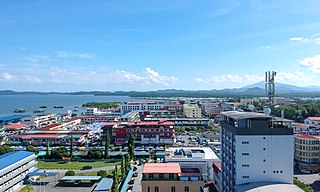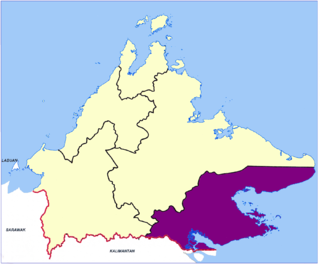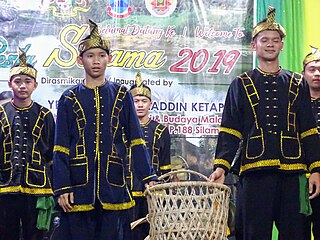Phonology

Vowels
| Front | Central | Back | |
|---|---|---|---|
| High | i | u | |
| Mid | e | ə | o |
| Low | a |
Consonants
| Bilabial | Alveolar | Palatal | Velar | Glottal | ||
|---|---|---|---|---|---|---|
| Nasal | m | n | ŋ | |||
| Plosive/ Affricate | Voiceless | p | t | tʃ | k | ʔ |
| Voiced | b | d | dʒ | ɡ | ||
| Fricative | s | |||||
| Liquid | Lateral | l | ||||
| Trill | r | |||||
| Semivowel | w | j | ||||
| Ida'an | |
|---|---|
| Begak | |
| Native to | Malaysia |
| Region | Lahad Datu, Kinabatangan, and Sandakan districts of Sabah |
Native speakers | 10,000 (2013) [1] |
Austronesian
| |
| Language codes | |
| ISO 639-3 | dbj |
| Glottolog | idaa1241 |
The Ida'an (also Idahan) language is a Malayo-Polynesian language spoken by the Ida'an people on the east coast of Sabah, Malaysia.
The language has a long literary history; the earliest known work in the language is a manuscript dated 1408 A.D. The manuscript, written using the Jawi script, gives an account of an Ida'an man named Abdullah in Darvel Bay who embraced Islam, with the region thus becoming one of the earliest known regions in Malaysia to embrace Islam. The Ida'an, Begak and Subpan peoples originally formed one ethnic group. The Ida'an converted to Islam following the conversion of Abdullah, while the Begak and Subpan continued to practice their traditional religion. [2]
The Ida'an language has been described as having three dialects: Ida'an proper (spoken in Sagama and several villages west of Lahad Datu), Begak (spoken in Ulu Tungku and several villages east of Lahad Datu), and Subpan (spoken in the districts of Kinabatangan and Sandakan). [3] These dialects correspond to three ethnic groups who originally formed a single group.
Lobel (2016) [4] lists Sungai Seguliud and Begak as Idaanic languages (language varieties closely related to Ida'an proper). The Begak dialect is said to be threatened with extinction, as younger speakers are switching to Malay.

| Front | Central | Back | |
|---|---|---|---|
| High | i | u | |
| Mid | e | ə | o |
| Low | a |
| Bilabial | Alveolar | Palatal | Velar | Glottal | ||
|---|---|---|---|---|---|---|
| Nasal | m | n | ŋ | |||
| Plosive/ Affricate | Voiceless | p | t | tʃ | k | ʔ |
| Voiced | b | d | dʒ | ɡ | ||
| Fricative | s | |||||
| Liquid | Lateral | l | ||||
| Trill | r | |||||
| Semivowel | w | j | ||||

Malay is an Austronesian language that is an official language of Brunei, Indonesia, Malaysia, and Singapore, and that is also spoken in East Timor and parts of the Philippines and Thailand. Altogether, it is spoken by 290 million people across Maritime Southeast Asia.

The Tausūg, are an ethnic group of the Philippines and Malaysia. A small population can also be found in the northern part of North Kalimantan, Indonesia. The Tausūg are part of the wider political identity of Muslim Filipinos of western Mindanao, the Sulu archipelago, and southern Palawan, collectively referred to as the Moro people. The Tausugs originally had an independent state known as the Sultanate of Sulu, which once exercised sovereignty over the present day provinces of Basilan, Palawan, Sulu, Tawi-Tawi, Zamboanga City, North Kalimantan and the eastern part of the Malaysian state of Sabah. They are also known in the Malay language as Suluk.

Maranao ; is an Austronesian language spoken by the Maranao people in the Provinces of Lanao del Sur and Lanao del Norte and the Cities of the Islamic City of Marawi and Iligan City in the Philippines, and in Sabah, Malaysia. Maranao People is the Major speakers and Most unique Language among the Danao language of the Moro People in the Bangsamoro Autonomous Region in Muslim Mindanao.

Lahad Datu is the capital of the Lahad Datu District in the Dent Peninsula on Tawau Division of Sabah, Malaysia. Its population was estimated to be around 27,887 in 2010. The town is surrounded by stretches of cocoa and palm oil plantations. It is also an important timber exporting port. The town has an airport for domestic flights.

Tawau Division is one of the five administrative sub-divisions of Sabah, Malaysia. It occupies a total of 14,905 square kilometres or 20% of Sabah's territory. The main towns include the capital of Tawau, Lahad Datu, Kunak and Semporna. Tawau division has 26% of Sabah's total population, with the main indigenous groups consisting of the Bajau, Suluk, Ida'an, Tidong, Cocos, Murut, Lun Bawang/Lun Dayeh as well as a minority of mixed ethnic groups. Large numbers of both legal and illegal immigrants from Indonesia such as the Buginese and Torajans, from East Timor the Timorese, from the Philippines the Tausūg and Visayans as well South and West Asian immigrants such as Pakistanis, Indians and Arabs can be found in this area. As with the rest of Sabah, the division also has large numbers of ethnic Chinese.

Semporna is the capital of the Semporna District in the Tawau Division of Sabah, Malaysia. Its population was estimated to be around 35,301 in 2010.

The Ida'an people are an ethnic group of Borneo, residing primarily in the Lahad Datu districts on the east coast of Sabah, Malaysia. Their current population is estimated to be around 6,000, but it appears that they once inhabited a much larger area along the east Sabah coast than present. For centuries, the Ida’an have owned exclusive rights to the collection of edible bird's nests in the limestone caves of the region, notably the Madai Caves. Most Ida'an are Sunni Muslims.

The Iranun are an Austronesian ethnic group native to southwestern Mindanao, Philippines. They are ethnically and culturally closely related to the Maranao, and Maguindanaon, all three groups being denoted as speaking Danao languages and giving name to the island of Mindanao. The Iranun were traditionally sailors and were renowned for their ship-building skills. Iranun communities can also be found in Malaysia and Indonesia.

The Kedayan are an ethnic group residing in Brunei, Federal Territory of Labuan, southwest of Sabah, and north of Sarawak on the island of Borneo. According to the Language and Literature Bureau of Brunei, the Kedayan language is spoken by about 30,000 people in Brunei, and it has been claimed that there are a further 46,500 speakers in Sabah and 37,000 in Sarawak. In Sabah the Kedayan mainly live in the cities of Sipitang, Beaufort, Kuala Penyu and Papar. In Sarawak the Kedayans mostly reside in Lawas, Limbang, Miri and the Subis area.
The Orang Sungei are a group of indigenous people native to the state of Sabah, Malaysia. Groups of communities live along the rivers of Kinabatangan, Labuk, Kudat, Pitas and Lahad Datu. The name "Orang Sungei" is a collective term that was first coined during the colonial British rule for communities living along the Kinabatangan River. In some cases like the Tambanuo people would refer to themselves as Orang Sungei for those who are Muslims; unless if they are not Muslims, then they would identify themselves by their tribal name. Whereas tribes like the Ida'an people are sometimes regarded as part of the Orang Sungei historically because of their common linguistic origins.
Melanau or A-Likou is an ethnic group indigenous to Sarawak, Malaysia. They are among the earliest settlers of Sarawak. They speak in the Melanau language, which is a part of the North Bornean branch of Malayo-Polynesian languages.

The earliest anatomically modern human skeleton in Peninsular Malaysia, Perak Man, dates back 11,000 years and Perak Woman dating back 8,000 years, were both discovered in Lenggong. The site has an undisturbed stone tool production area, created using equipment such as anvils and hammer stones. The Tambun rock art is also situated in Perak. From East Malaysia, Sarawak's Niah Caves, there is evidence of the oldest human remains in Malaysia, dating back 40,000 years.
The Dusunic languages are a group of languages spoken by the Bisaya and Dusun, and related peoples in the Malaysian province of Sabah on Borneo.
The Sabahan languages are a group of Austronesian languages centered on the Bornean province of Sabah.
Molbog is an Austronesian language spoken in the Philippines and Sabah, Malaysia. The majority of speakers are concentrated at the southernmost tip of the Philippine province of Palawan, specifically the municipalities of Bataraza and Balabac. Both municipalities are considered as bastions for environmental conservation in the province. The majority of Molbog speakers are Muslims.

The Iranun language, also known as Iranon or Illanun, is an Austronesian language belonging to the Danao languages spoken in the provinces of Maguindanao del Norte and other part of Lanao del Sur and Lanao del Norte, coastal municipalities of Zamboanga del Sur from Tukuran to Dumalinao and Cotabato in southern Philippines and the Malaysian state of Sabah. It is the second most spoken language in Maguindanao after the Maguindanao language.

The 2013 Lahad Datu standoff, also known as the Lahad Datu incursion or Operation Daulat, was a military conflict in Lahad Datu District, Sabah, Malaysia, that started on 11 February 2013 and lasted until 24 March 2013. The conflict began when 235 militants, some of whom were armed, arrived by boats to Lahad Datu from Simunul island, Tawi-Tawi, in the southern Philippines. The group, calling themselves the "Royal Security Forces of the Sultanate of Sulu and North Borneo", was sent by Jamalul Kiram III, one of the claimants to the throne of the Sultanate of Sulu.
Dumpas is a Dusunic language of Malaysia.

Sabah is the third most populous state in Malaysia, with a population of 3,418,785 according to the 2020 Malaysian census. It also has the highest non-citizen population, at 810,443. Although Malaysia is one of the least densely populated countries in Asia, Sabah is particularly sparsely populated. Most of the population is concentrated along coastal areas, with towns and urban centers seeing the most population growth.

The Lahad Datu District is an administrative district in the Malaysian state of Sabah, part of the Tawau Division which includes the districts of Kunak, Lahad Datu, Semporna and Tawau. The capital of the district is in Lahad Datu Town.